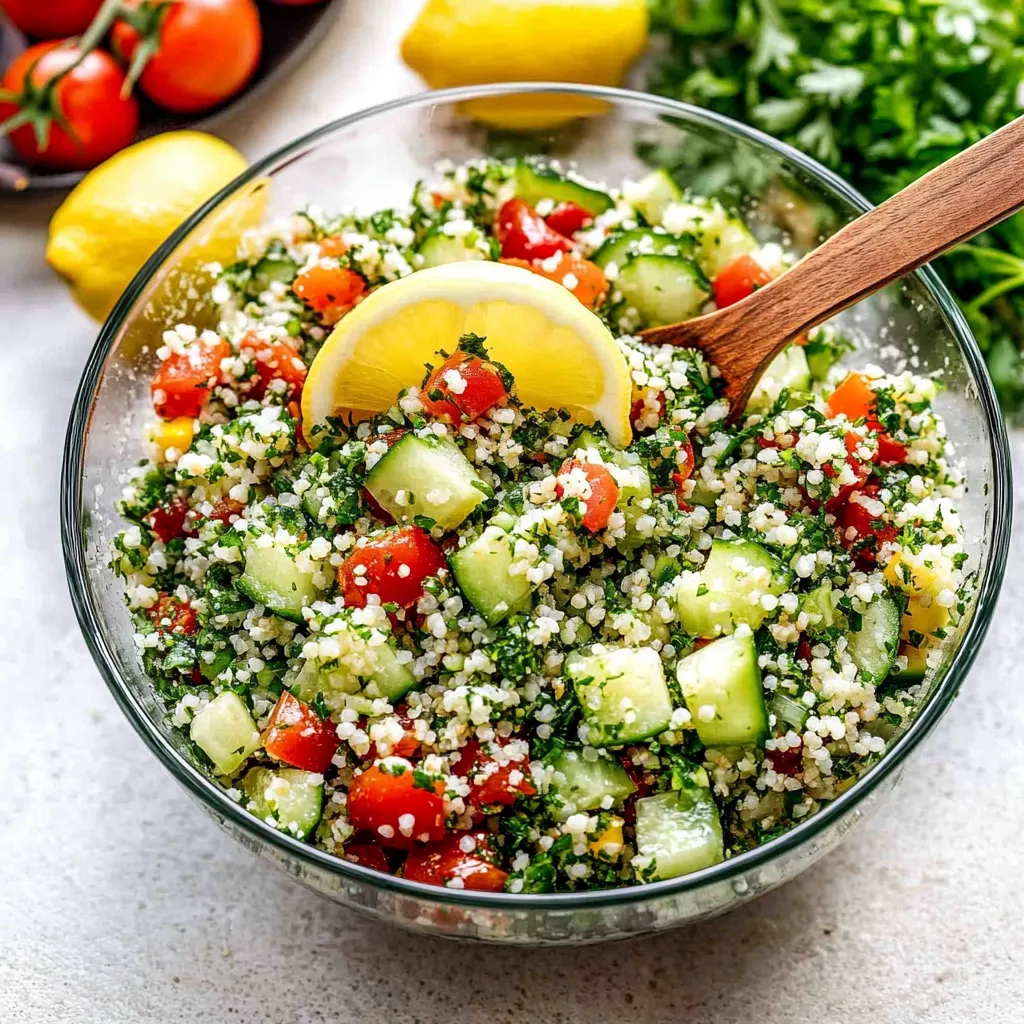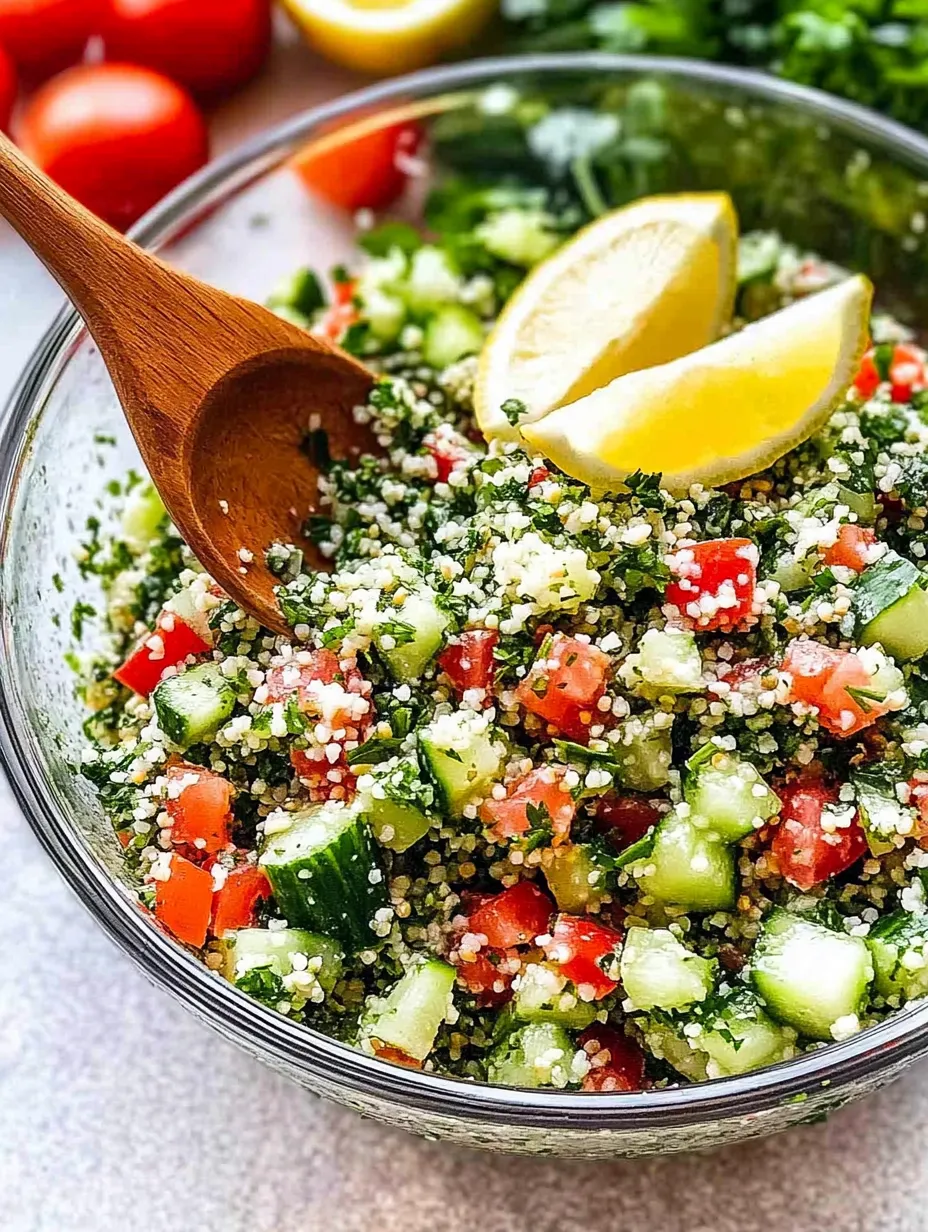 Pin it
Pin it
Vibrant green herbs mingle with nutty bulgur and juicy vegetables in this refreshing Mediterranean classic that brings sunshine to any table. Traditional tabbouleh celebrates the bright flavors of fresh parsley and mint, complemented by the subtle texture of bulgur wheat and enlivened with ripe tomatoes and crisp cucumber. The simple lemon dressing ties everything together, creating a light yet satisfying dish that captures the essence of Levantine cuisine in every forkful.
I discovered authentic tabbouleh during a trip through small coastal villages in Lebanon where families served massive platters heaped with more parsley than I'd ever seen in a single dish. The local grandmother who shared her recipe insisted that "real tabbouleh is a parsley salad with a little bulgur, not a bulgur salad with a little parsley." After numerous attempts to recreate that vibrant flavor at home, this version finally captures the perfect balance that transported me back to that sunlit Mediterranean table.
Fresh Ingredient Selection
- Bulgur Wheat: Provides subtle nutty flavor and pleasing texture without overwhelming the herbs. Fine or medium grind bulgur creates the most authentic texture in the finished salad.
- Diced Tomatoes: Add juicy sweetness that balances the lemony dressing. Choose fully ripe tomatoes at the peak of their flavor for the best results.
- English Cucumber: Contributes refreshing crunch and subtle flavor. The thin skin and minimal seeds make it ideal for tabbouleh compared to regular cucumbers.
- Curly Parsley: Creates the distinctive green foundation essential to authentic tabbouleh. The curly variety holds dressing better than flat leaf parsley would.
- Fresh Mint: Provides aromatic brightness that elevates the entire dish. Look for vibrant green leaves without any black spots or wilting.
- Green Onions: Add gentle allium flavor without overpowering the delicate herbs. Both white and green parts contribute different flavor notes to the finished salad.
- Garlic Clove: Introduces subtle background pungency that rounds out the flavor profile. Finely mincing ensures even distribution throughout the salad.
- Extra Virgin Olive Oil: Forms the rich foundation of the dressing that carries flavor throughout each bite. Choose a high quality oil with fruity rather than bitter notes.
- Lemon Juice: Provides essential brightness and acidity that defines tabbouleh's character. Freshly squeezed juice delivers significantly better flavor than bottled.
- Salt: Enhances all other flavors while drawing excess moisture from vegetables. Kosher salt distributes more evenly throughout the salad than table salt.
- Black Pepper: Adds subtle warmth and complexity that balances the bright herbs. Freshly ground pepper provides much more flavor than pre ground varieties.
Tabbouleh Creation Method
- Prepare The Bulgur
- Cook according to package directions until just tender, being careful not to overcook which would create a mushy texture in the finished salad.
- Cool Completely
- Spread cooked bulgur on a baking sheet to cool quickly and prevent it from continuing to soften, preserving the distinct grain texture essential to good tabbouleh.
- Extract Excess Moisture
- Dice tomatoes and cucumbers, then sprinkle with salt and place in a colander to drain, preventing them from making the salad watery as it sits.
- Prepare Herbs Properly
- Remove tough stems from parsley before finely chopping both parsley and mint, creating the fine texture that allows herbs to distribute evenly throughout.
- Create Flavor Base
- Combine sliced green onions with minced garlic, allowing their flavors to mellow slightly before adding other ingredients.
- Layer Ingredients Thoughtfully
- Add cooled bulgur to herbs first, allowing the grains to separate and distribute evenly before introducing the more delicate vegetables.
- Incorporate Vegetables
- Gently fold drained tomatoes and cucumbers into the herb mixture, being careful not to crush them which would release more liquid.
- Dress With Care
- Whisk olive oil, fresh lemon juice, salt and pepper until emulsified, then drizzle over the salad while folding gently to coat all ingredients evenly.
- Allow Flavors To Meld
- Let the dressed salad rest for at least fifteen minutes before serving, allowing the bulgur to absorb some of the dressing and the flavors to harmonize completely.
- Taste And Adjust
- Before serving, taste and adjust seasoning as needed, often adding a final squeeze of lemon juice to brighten all the flavors.
My personal connection to tabbouleh developed after planting an enormous parsley patch in my garden, requiring weekly harvesting to keep it from taking over. Searching for ways to use massive bunches led me to perfect this recipe, which my family now requests whenever the parsley threatens to overtake the garden beds. What began as a practical solution has become our favorite summer side dish, especially alongside grilled fish or lamb on warm evenings when heavy food seems unappealing.
 Pin it
Pin it
Texture Balance Matters
Achieving the perfect texture in tabbouleh requires attention to several elements that might seem minor but significantly impact the final dish. The bulgur should be cooked until just tender, maintaining distinct grains rather than becoming soft or porridge like. Vegetables must be diced into pieces small enough to integrate well with the herbs but large enough to provide textural contrast with each bite. Most importantly, the parsley and mint should be chopped finely but not pulverized, which would release too much moisture and create a mushy consistency. This careful balance of textures creates the distinctive mouthfeel that makes authentic tabbouleh so satisfying.
Regional Authenticity Notes
While tabbouleh has gained popularity worldwide, regional variations throughout the Mediterranean and Middle East reflect local preferences and available ingredients. Lebanese tabbouleh typically contains the highest ratio of herbs to bulgur, creating an intensely green salad. Syrian versions often incorporate more bulgur and sometimes include cinnamon or allspice for subtle warmth. Turkish variations might include pomegranate molasses in the dressing for sweet tanginess. Palestinian tabbouleh occasionally incorporates finely diced bell peppers for additional color and crunch. Understanding these regional differences allows you to appreciate the cultural context of this beloved salad while creating your own preferred version.
Make Ahead Strategies
Tabbouleh offers excellent opportunities for advance preparation, with several approaches depending on when you plan to serve it. For serving within 24 hours, prepare the complete salad including dressing, allowing flavors to meld in the refrigerator. For longer advance preparation, keep components separate: store cooked bulgur, chopped herbs, and diced vegetables in individual containers, combining and dressing just before serving. Another effective approach involves preparing everything except the tomatoes ahead of time, adding them just before serving to prevent excess moisture from being released into the salad during storage. Each method preserves the vibrant flavors and textures that make tabbouleh special.
Creative Serving Ideas
Transform this traditional salad into an impressive presentation through thoughtful serving techniques. For casual gatherings, serve tabbouleh in hollowed out tomatoes or cucumber boats for individual portions that double as edible serving vessels. Create an elegant plated appetizer by molding tabbouleh in ring molds, then garnishing with yogurt sauce and pine nuts. For buffet service, arrange tabbouleh on a large platter surrounded by endive leaves, allowing guests to create individual scoops filled with the salad. When serving as part of a mezze spread, place tabbouleh in a separate bowl but adjacent to hummus, creating the opportunity for guests to combine the two for a traditional Middle Eastern pairing.
Seasonal Adaptations
While traditional tabbouleh follows a specific formula, seasonal adaptations can create delicious variations throughout the year. Summer versions benefit from the addition of stone fruits like finely diced peaches or nectarines that complement the lemony dressing beautifully. Fall adaptations might incorporate pomegranate seeds for juicy bursts of flavor and visual appeal. Winter tabbouleh can incorporate citrus segments such as blood orange or grapefruit when fresh tomatoes lack flavor. Spring versions shine with the addition of tender peas or fava beans that introduce delicate sweetness. Each variation maintains the herb forward character while introducing seasonal elements that keep this classic dish exciting year round.
 Pin it
Pin it
Dietary Modifications
Adapt this versatile salad to accommodate various dietary needs without sacrificing its essential character. Create gluten free tabbouleh by substituting quinoa, millet, or cauliflower rice for the traditional bulgur wheat. For a grain free version, use finely chopped cauliflower or broccoli stems in place of bulgur. Increase protein content by adding chickpeas or white beans for a more substantial main dish salad. Reduce oil content for low fat diets by replacing half the olive oil with additional lemon juice or a splash of vegetable broth. Each modification maintains the bright herb forward profile while adapting to specific nutritional requirements.
The connection between tabbouleh and Mediterranean culture runs deep, reflecting values of freshness, simplicity, and making the most of seasonal abundance. My grandmother always said that you could judge a cook's skill by their tabbouleh, noting how the perfect balance requires both technique and intuition. What continues to delight me about this dish is how it transforms humble ingredients into something extraordinary through thoughtful preparation rather than complicated techniques. The way it brightens a table with its vibrant color while refreshing the palate makes tabbouleh much more than a simple salad, it becomes a celebration of fresh flavors that connects us to centuries of Mediterranean culinary tradition.
Frequently Asked Questions
- → Can I make tabbouleh without bulgur wheat?
- Yes! For a gluten-free version, you can substitute quinoa or use cauliflower rice. Some traditional Lebanese versions use very little grain, focusing primarily on the herbs and vegetables.
- → Why do I need to salt and drain the tomatoes and cucumbers?
- This step draws out excess moisture that would otherwise make your salad soggy. The salt helps extract the water from the vegetables, keeping your tabbouleh fresh and crisp.
- → How far in advance can I make tabbouleh?
- Tabbouleh can be made up to 24 hours ahead and stored in the refrigerator. The flavors actually improve as they meld together, but the herbs may darken slightly over time.
- → Is there a shortcut for chopping all that parsley?
- You can use a food processor to chop the parsley and mint, but be careful not to over-process. Pulse in short bursts until finely chopped but not mushy. Traditional tabbouleh uses hand-chopped herbs for the best texture.
- → What can I serve with tabbouleh salad?
- Tabbouleh pairs wonderfully with grilled meats, falafel, hummus, or stuffed grape leaves. It's also great in a Mediterranean mezze platter with pita bread and other dips like baba ganoush or tzatziki.
- → Can I add other ingredients to my tabbouleh?
- While traditional tabbouleh has simple ingredients, you can customize it by adding feta cheese, chickpeas, olives, or bell peppers. Just keep the focus on fresh herbs, which are the star of this salad.
